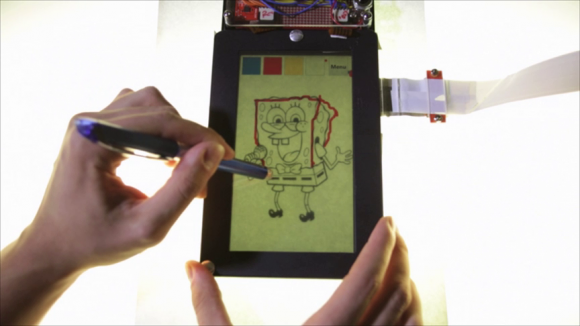« Back to Projects list

Transparent (Optical See-Through) Displays
The recent commercial availability of transparent display technologies is in stark contrast with the lack of research on their usages and opportunities. In this project we focus on exploring/solving several important yet unique factors of transparent displays, ranging from their design and application to usability problems.
The display technologies used and explored in this project:
1) Projection based window see-through display
2)Transparent LCD display
3)Transparent HMD (Head Mounted Display)
4)Transparent Organic Light emitting diode(T-OLED)
Funded by NSERC
Video
A brief summary of various published and on-going research are as follows:
1) Usability problem: Color correction for see-through display:
In optical see-through displays, light coming from background objects mixes with the light originating from the display, causing what is known as the color blending problem. Color blending negatively affects the usability of such displays as it impacts the legibility and color encodings of digital content. Color correction aims at reducing the impact of color blending by finding an alternative display color which, once mixed with the background, results in the color originally intended.
In this paper we model color blending based on two distortions induced by the optical see-through display. The render distortion explains how the display renders colors. The material distortion explains how background colors are changed by the display material. We show the render distortion has a higher impact on color blending and propose binned-profiles (BP) - descriptors of how a display renders colors - to address it. Results show that color blending predictions using BP have a low error rate - within nine just noticeable differences (JND) in the worst case. We introduce a color correction algorithm based on predictions using BP and measure its correction capacity. Results show light display colors can be better corrected for all backgrounds. For high intensity backgrounds light colors in the neutral and CyanBlue regions perform better. Finally, we elaborate on the applicability, design and hardware implications of our approach.
2) Transparent Display Exhibition Cases
Interactive technologies in museums enhance the visit experience by providing contextual information and fostering collaboration and participation. In this paper we revisit the design of the ubiquitous transparent exhibition case from a museum learning perspective. Transparent cases with interactive properties can complement other museum technologies and mitigate some of their shortcomings, such as the group isolation caused by audio guides and mobile devices. This paper focuses on the design of interactive cases and makes three contributions. First, based on field observations and interviews we present a list of requirements for interactive cases. Second, we propose a design space with dimensions grouped around the themes of hardware, interaction and information design. Our design space suggests interactive cases which present collocated information at increasing levels of detail, facilitate social interaction, and integrate with other technologies. Third, we demonstrate our design space through sample case designs and discuss the general technical challenges.
3) tPad: Designing Transparent Display Mobile Interactions
As a novel class of mobile devices with rich interaction capabilities we introduce tPads – transparent display tablets. tPads are the result of a systematic design investigation into the ways and benefits of interacting with transparent mobiles which goes beyond traditional mobile interactions and augmented reality (AR) applications. Through a user-centered design process we explored interaction techniques for transparent-display mobiles and classified them into four categories: overlay, dual display & input, surface capture and model-based interactions. We investigated the technical feasibility of such interactions by designing and building two touch-enabled semi-transparent tablets called tPads and a range of tPad applications. Further, a user study shows that tPad interactions applied to everyday mobile tasks (application switching and image capture) outperform current mobile interactions and were preferred by users. Our hands-on design process and experimental evaluation demonstrate that transparent displays offer novel valuable interaction opportunities for mobile devices.
Project Publications
SmartColor: Real-Time Color Correction and Contrast for Optical See-Through Head-Mounted Displays
Hincapié-Ramos, J.D., Ivanchuk, L., Sridharan, S.K. and Irani, P. 2014. SmartColor: Real-Time Color Correction and Contrast for Optical See-Through Head-Mounted Displays. In Proc. ISMAR ’14. ACM. To Appear.
cAR: Contact Augmented Reality with Transparent-Display Mobile Devices
Hincapié-Ramos, J.D., Roscher, S., Büschel, W., Kister, U., Dachselt, R. and Irani, P. 2014. cAR: Contact Augmented Reality with Transparent-Display Mobile Devices. In Proceedings of the 3rd ACM International Symposium on Pervasive Displays (PerDis '14). ACM. To Appear.
tPad: Designing Transparent-Display Mobile Interactions
Hincapié-Ramos, J.D., Roscher, S., Büschel, W., Kister, U., Dachselt, R. and Irani, P. 2014. tPad: Designing Transparent-Display Mobile Interactions. In Proceedings of the 10th ACM Conference on Designing Interactive Systems (DIS '14). ACM. Honorable Mention Award.
Designing Interactive Transparent Exhibition Cases
Hincapié-Ramos, J. D., Guo, X. and Irani, P. 2014. Designing Interactive Transparent Exhibition Cases. Proceedings of the third international ACM workshop on Personalized access to cultural heritage (PATCH ’14). February 2014. ACM.
Color Correction for Optical See-Through Displays Using Display Color Profiles
Sridharan, S.K., Hincapié-Ramos, J.D., Flatla, D.R. and Irani, P. 2013. Color correction for optical see-through displays using display color profiles. In Proceedings of the 19th ACM Symposium on Virtual Reality Software and Technology (VRST '13). ACM, New York, NY, USA, 231-240.












